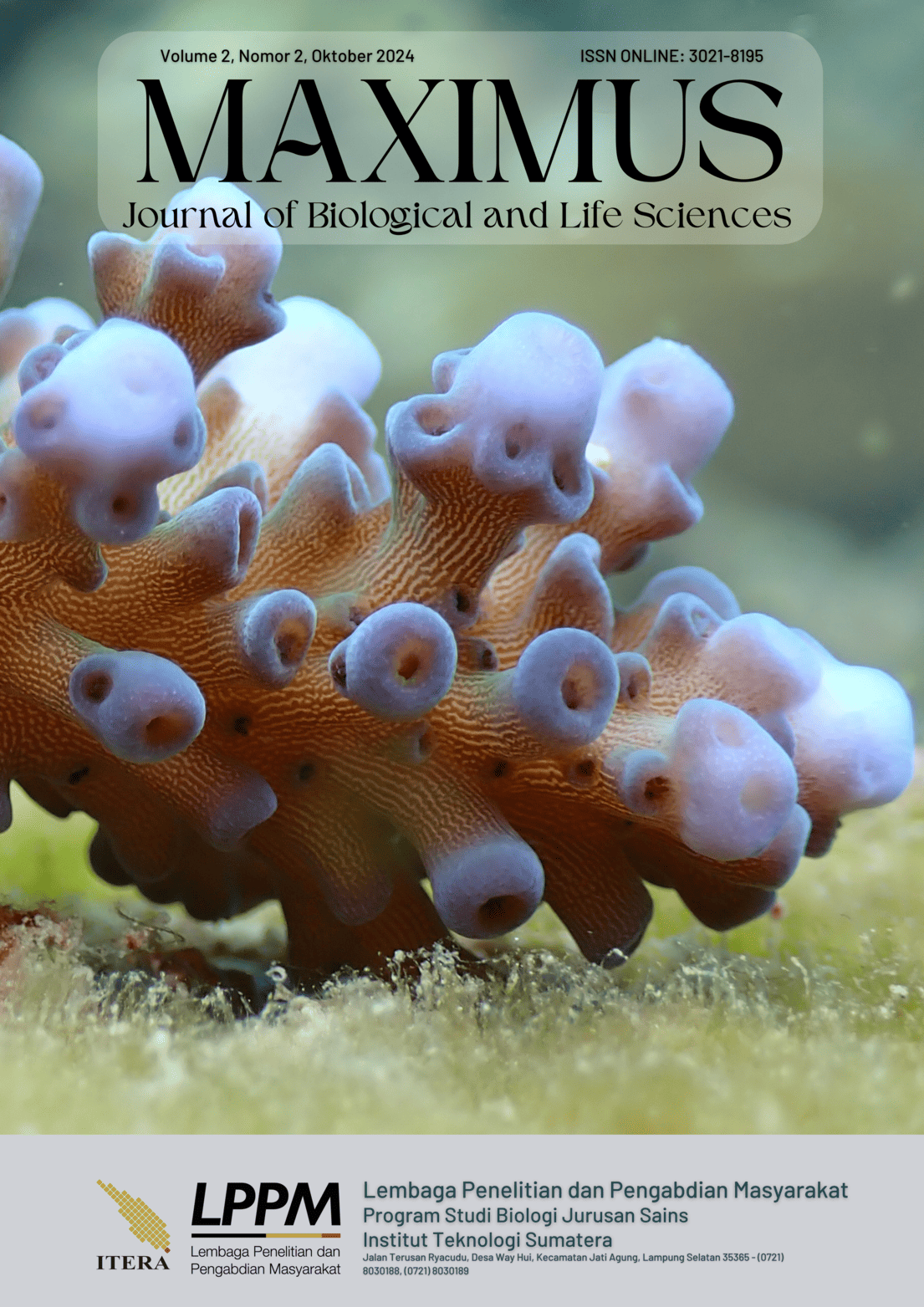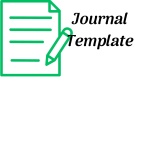SURVEI TUTUPAN KARANG DAN KOMPOSISI IKAN KARANG DI PERAIRAN PLTU SEBALANG, LAMPUNG SELATAN
Abstract
Terumbu karang merupakan ekosistem produktif yang menghadapi ancaman kerusakan akibat penangkapan ikan ilegal dan pembangunan pesisir yang tidak berkelanjutan. Praktik penangkapan ikan ilegal dan pembangunan area pesisir diduga berkontribusi pada penurunan tutupan karang hidup di perairan PLTU Sebalang, Lampung Selatan. Informasi mengenai kondisi ekosistem terumbu karang di area PLTU Sebalang Lampung Selatan saat ini masih belum memadai. Oleh sebab itu perlu dilakukan survei kesehatan terumbu karang di area ini sebagai bagian dari langkah pengelolaan ekosistem terumbu karang secara berkelanjutan. Penelitian ini dilakukan pada bulan Januari 2024 di perairan PLTU Sebalang. Pengambilan data terumbu karang menggunakan metode Underwater Photo Transect (UPT) yang dikombinasikan dengan program identifikai karang CPCe (Coral Point Count with Excel extensions). Pengambilan data ikan karang menggunakan metode Underwater Visual Census (UVC). Hasil penelitian ini menunjukkan kondisi tutupan terumbu karang pada seluruh titik penelitian dikategorikan buruk. Persen tutupan karang terendah berada pada titik 1 kedalaman 8 meter yaitu sebesar 1.53%. Sedangkan kondisi tutupan karang pada titik 2 kedalaman 8 meter memiliki persentase tertinggi yaitu sebesar 23.28%. Ikan karang yang ditemukan sebanyak 10 famili yang terdiri dari Apogonidae, Aulostomidae, Caesonidae, Chaetodontidae, Haemulidae, Holocentridae, Labridae, Nemipteridae, Pomacentridae, dan Pempherididae. Faktor yang mempengaruhi buruknya kondisi tutupan terumbu karang dan sedikitnya jumlah individu ikan karang yang terdapat pada seluruh titik pengamatan dipengaruhi oleh faktor tingginya sedimentasi, kuatnya arus perairan, dan nelayan jaring payang yang menangkap ikan hingga ke dasar perairan.
Coral reefs are productive ecosystems that face significant threats from illegal fishing and unsustainable coastal development. These practices are suspected of contributing to the decline in live coral cover in the waters surrounding the Sebalang Power Plant (PLTU Sebalang), South Lampung. Current information on the coral reef ecosystem in this area remains insufficient. Therefore, a coral health survey is essential as part of sustainable management efforts. This study was conducted in January 2024 in the waters of PLTU Sebalang. Coral reef data were collected using the Underwater Photo Transect (UPT) method, combined with the Coral Point Count with Excel extensions (CPCe) software for coral identification. Data on reef fish were gathered using the Underwater Visual Census (UVC) method. The results indicate that coral reef cover at all study sites was categorized as poor. The lowest coral cover was recorded at Site 1 at a depth of 8 meters, with only 1.53% coverage, while the highest cover was observed at Site 2, also at a depth of 8 meters, with 23.28%. A total of 10 reef fish families were identified, including Apogonidae, Aulostomidae, Caesonidae, Chaetodontidae, Haemulidae, Holocentridae, Labridae, Nemipteridae, Pomacentridae, dan Pempherididae. The poor condition of coral cover and the low number of individual reef fish at all observation sites were influenced by high sedimentation, strong currents, and the use of payang nets by fishermen, which reach the seabed.
Downloads
References
Giyanto et al. (2014) Panduan monitoring kesehatan terumbu karang. Available at: http://www.coremap.or.id.
Hughes, T.P. et al. (2003) ‘Climate Change, Human Impacts, and the Resilience of Coral Reefs’, Science, 301(5635), pp. 929–933. Available at: https://doi.org/10.1126/science.1085046.
Jaap, W.C. (2000) ‘Coral reef restoration’, Ecological Engineering, 15(3), pp. 345–364. Available at: https://doi.org/https://doi.org/10.1016/S0925-8574(00)00085-9.
Khasanah, R.I. et al. (2020) ‘Growth rate and survivorship of Acropora sp. fragments that transplanted on the artificial substrate made from fly ash and bottom ash’, IOP Conference Series: Earth and Environmental Science, 441(1). Available at: https://doi.org/10.1088/1755-1315/441/1/012126.
Manuputty, A.E.W. and Djuwariah (2009) ‘Point Intercept Transect (PIT) untuk Masyarakat Studi Baseline dan Monitoring Kesehatan Karang di Lokasi Daerah Perlindungan Laut (DPL)’, Coremap Ii - Lipi, p. 73.
Morse, D.E. et al. (1988) ‘Control of larval metamorphosis and recruitment in sympatric agariciid corals’, Journal of Experimental Marine Biology and Ecology, 116(3), pp. 193–217. Available at: https://doi.org/10.1016/0022-0981(88)90027-5.
Oliveira, M. De et al. (2020) ‘Microplastics in corals : An emergent threat’, Marine Pollution Bulletin, 161(PA), p. 111810. Available at: https://doi.org/10.1016/j.marpolbul.2020.111810.
Razak, T.B. et al. (2022) ‘Coral reef restoration in Indonesia: A review of policies and projects’, Marine Policy, 137, p. 104940. Available at: https://doi.org/10.1016/j.marpol.2021.104940.
Rhyne, A.L. et al. (2012) ‘future opportunities for ecosystem and societal benefits’, 5, pp. 478–485. Available at: https://doi.org/10.1111/j.1755-263X.2012.00265.x.
Richmond, R. and Hunter, C. (1990) ‘Reproduction and recruitment of corals: comparisons among the Caribbean, the Tropical Pacific, and the Red Sea’, Marine Ecology Progress Series [Preprint]. Available at: https://doi.org/10.3354/meps060185.
Tuttle, L.J. and Donahue, M.J. (2022) ‘Effects of sediment exposure on corals: a systematic review of experimental studies’, Environmental Evidence, 11(1), pp. 1–33. Available at: https://doi.org/10.1186/s13750-022-00256-0.
Copyright (c) 2024 M Khairul Anam, Novriadi Novriadi

This work is licensed under a Creative Commons Attribution-NonCommercial 4.0 International License.
All rights, title and interest in the copyright to manuscript submitted, if accepted, are hereby transferred to Maximus : Journal of Biology and Life Sciences. This includes display of the accepted article in electronic form on the internet before and/or after print publication (if any). The authors must confirm that the manuscript contains no material that would violate the copyright or any other right of any other person. The authors reserve unto themselves the following rights the right to make copies for personal teaching use, and to reproduce reasonable quantities for personal use only; the right to reuse figures and tables in articles published in other books or journals (with bibliographic reference to Maximus : Journal of Biology and Life Sciences); any proprietary rights other than copyright, including the right to any patentable subject matter contained in the manuscript and the right to deny any subsequent commercial use.







